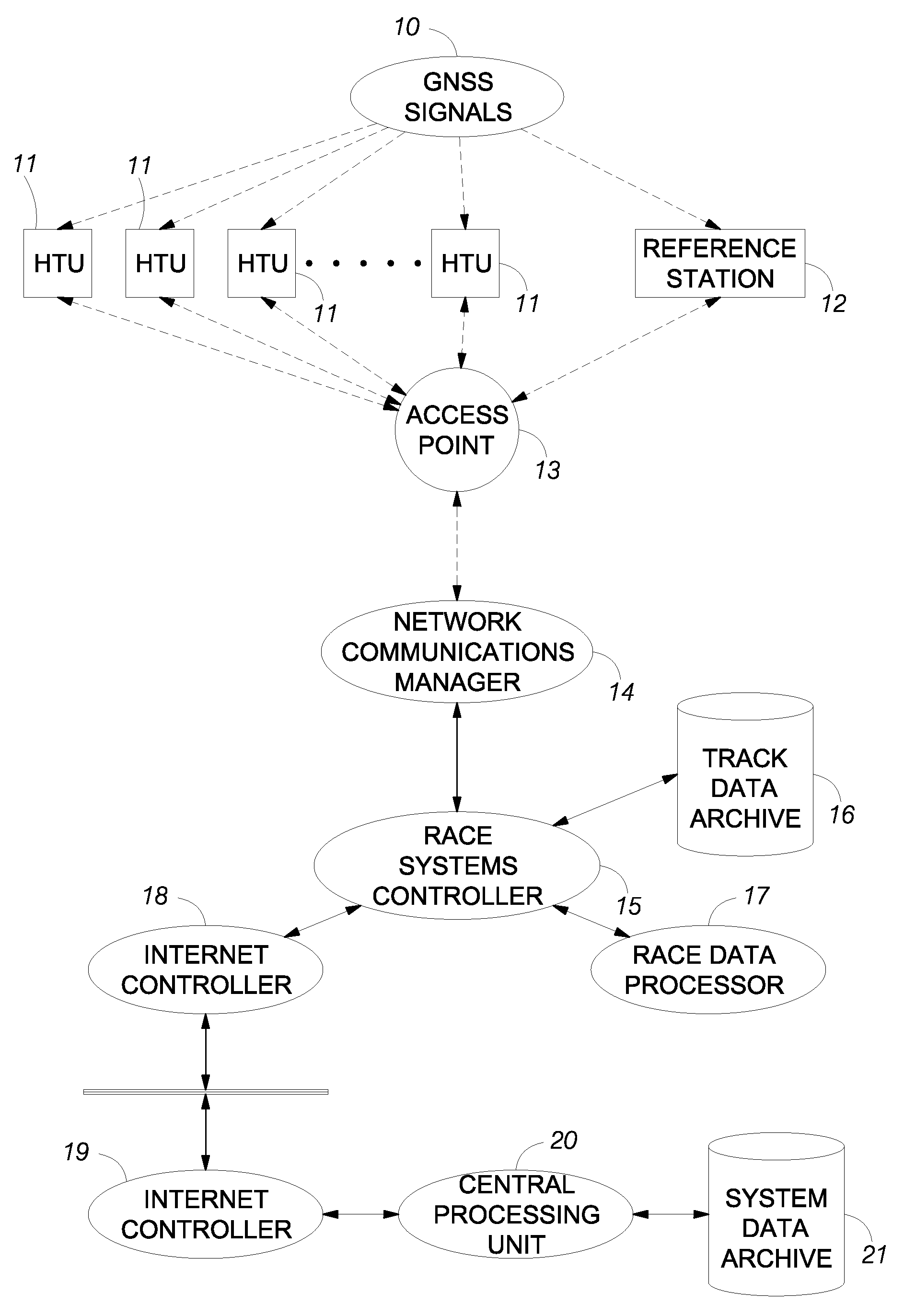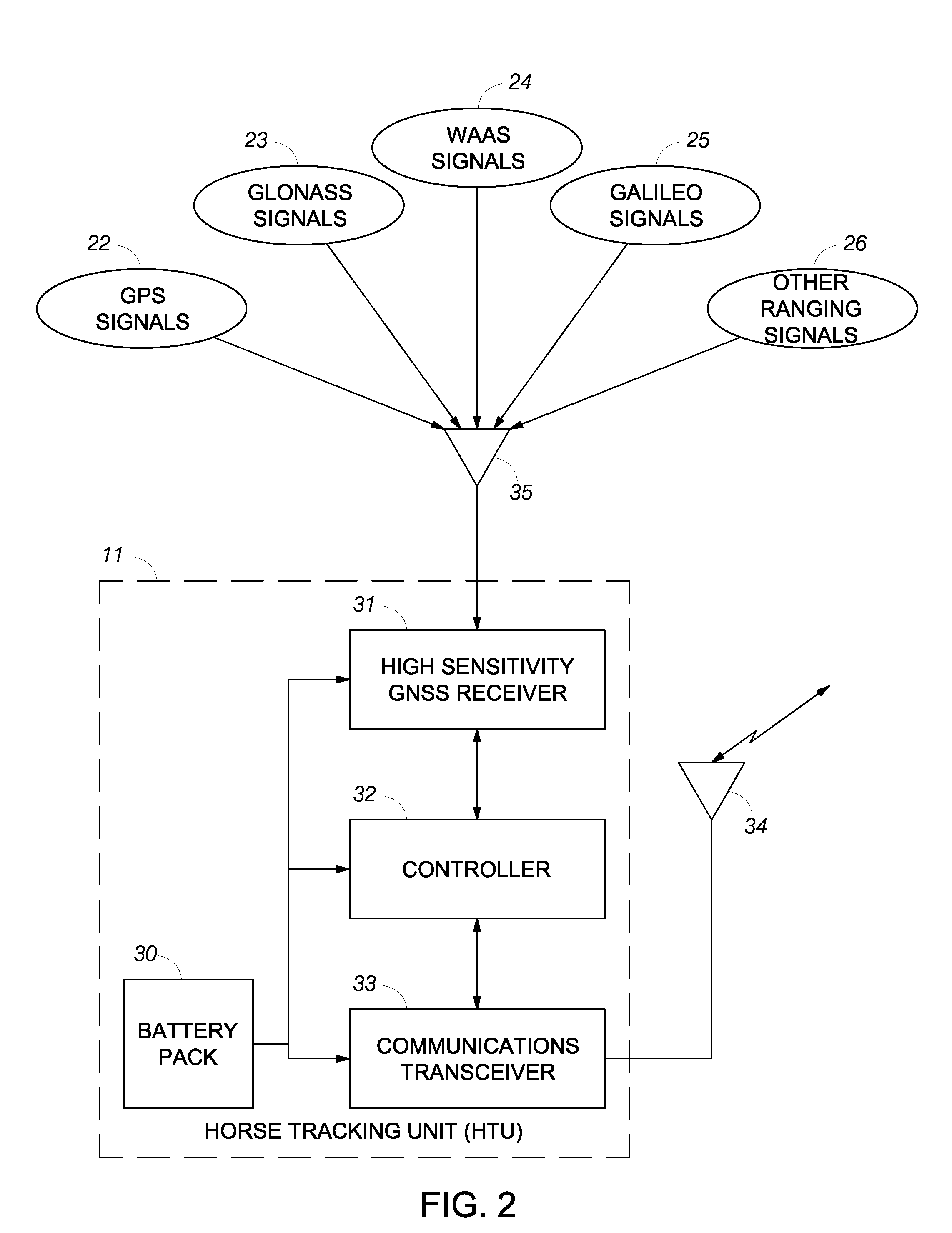[0009]One aspect in accordance with embodiments of the present invention described herein is a GPS-based or other GNSS-based system and methods that acquire, collect, and process data that enables the system and method to continuously track one or more race horses in real time. The system includes a horse (or jockey) mounted tracking device that receives signals from satellites, a communications link, and a centralized
workstation that performs specialized computations on the data received by the tracking device to provide precise tracking and timing of the movements of the horse.
[0010]The GPS-based horse tracking unit GPS / HTU system described herein has virtually no
impact to the racetrack infrastructure. Unlike some attempts to provide electronic monitoring of horse races, the racetrack does not have to be torn up to install sensors at a plurality of locations in order to implement the GPS / HTU system. Furthermore, only one or a few antennas need to be installed to receive the signals transmitted by the tracking units mounted on the horses or jockeys. Accordingly, unlike other attempts to provide electronic monitoring, the GPS / HTU system does not require a plethora of unsightly antennas situated around the racetrack. Furthermore, extensive wiring around the racetrack is not required. Unlike systems having a plurality of sensors, the GPS / HTU system does not require complex calibrations. Accordingly, the GPS / HTU system has a very low installation cost compared to previously considered RF systems. The GPS / HTU system also has a low
operational complexity and does not require on-going calibration or
engineering in order to maintain the high level of accuracy.
[0011]The GPS / HTU system is responsive to GPS or other GNSS signals to provide a continuous
tracking system for racetracks during racing events. The
tracking system operates even in track environments having blocked or obstructed locations and other features that cause difficult
signal acquisition and tracking. The GPS / HTU system incorporates robust
code tracking with carrier smoothed GPS and / or other GNSS measurements. Accordingly, the GPS / HTU system provides
high availability without blockages or outages at any locations on the racetrack at all tracks within the United States or throughout the world. The high accuracy of the GPS / HTU system accounts for multipath errors and other GPS signal errors. Because of the high sensitivities of the receivers in the horse tracking units, the GPS / HTU system provides a fast
time to first fix (TTFF) ability, which includes the ability to track the location of each horse inside the starting gate and continuously after the horse leaves the starting gate. Because the horse tracking units are small and have a low weight, the horse tracking units may be secured to the horses or to the jockeys without affecting the performances of the horses. The units can also be mounted on other moving objects and used to track the objects.
[0012]As described herein, the GPS / HTU system can replace the existing chart callers as well as existing track timing systems to provide a more accurate and
continuous measurement of multiple race horses during a racing event. As a
timing system, the GPS / HTU system is able to determine the
start time for each horse, and then monitor the location and velocity of each horse continuously at a rate greater than 1 Hz (e.g., 2-10 times per second) thereafter to provide very accurate and precise tracking at every location on the entire track course. In contrast, conventional timing systems only trip when the first horse leaves the starting gate and when the first horse crosses the
finish line and therefore, cannot always determine which horse caused an event. The GPS / HTU system is not affected by false alarms caused by dust,
fog,
snow, birds and bugs and is not subject to varying qualities of timing due to the wide variety and age of photoelectric sensors currently deployed in the horseracing industry. In view of the economical installation and operation, the GPS / HTU system is able to provide workout performance tracking as well as tracking of real-time race performance.
[0013]Among the characteristics that enable the GPS / HTU system to provide the continuous accurate performance described herein is the selection of a
receiver having a high
signal sensitivity (e.g., ability to acquire and track signals with power levels less than −154
dBm), having a large number of equivalent correlators (e.g., greater than 30,000), and having a high
measurement frequency (greater than 1 Hz, and preferably at least 4 Hz). The GPS / HTU system further benefits from the use of adaptive Kalman filtering and centralized error correction
processing rather than computing a GPS solution within the tracking unit mounted on each horse or other moving object. In particular, the use of centralized
processing with sufficient processing power enables the GPS / HTU system to implement multiple adaptive Kalman filters so that the
Kalman filter parameters can be dynamically selected for the signals for each satellite visible to the
receiver in each horse tracking unit. The GPS / HTU also uses adaptive measurement rejection, adaptive measurement weighting and adaptive
process noise as part of the centralized processing of corrections to apply to the computed
pseudorange and
delta pseudorange values. Because of variations in the geographies and structures of racetracks and due to the kinematic limitations of a horse race, the GPS / HTU system includes geographic and kinematic aiding corrections, which provide dynamic and positional aiding corrections applied to the measurements to further improve the accuracy of the computed locations of the horses. Due to the ability to track low signal levels, the geographic and kinematic aiding corrections include
ray tracing
multipath mitigation and corrections for
diffraction,
refraction and attenuation effects of the satellite signals caused by structures and other objects
proximate to a racetrack.
[0023]In certain embodiments, the method also provides position data for each object in a competition to a plurality of users during the competition to enable the users to determine the relative positions of the objects at predetermined locations along the known course competition in addition to the relative positions of the objects at the end of the known course. In certain embodiments, the method enables the plurality of users to enter additional wagers on the relative positions of the objects at the end of the competition based on relative positions of objects at predetermined locations towards the beginning of the competition.
 Login to View More
Login to View More  Login to View More
Login to View More 


